


Lignum Vitae
Below you'll find some reference material concerning Lignum Vitae. Given the way websites seem to be disappearing these days, I thought it would be a good idea to cache a snap-shot of each reference.
"Guaiacum officinale -- "Wood of Life" The heaviest densest wood in the world. Beautiful black green and brown grain. Turns like plastic in the lathe. 80+lbs per cubic foot." -- Cocobolo Inc.
"Lignum Vitae,
(Guaiacum Officinale)
This small tree, native to the Antilles, is characteristic
of xerophilous regions. Its wood, once commercially
used in construction because of its density, was so
exploited that the Gaiac, as it is locally called, is now a
protected species. The bark of the Gaiac tree was
used in times past for medicinal purposes; namely, to
treat syphilis. Its sap was also attributed with the
power to relieve arthritis. Its glossy leaves are a rich
green and in general, this tree flowers twice a year. Its
abundant flowers range in color from purple to blue
and pale over time. Its orange-colored fruit is about 2
cm in diameter."
-- St. Barth
"lignum vitae
Pronounced As: lignm vit [Lat.,=wood of life], tropical
American evergreen tree of the genus Guaiacum. The hard,
dense, and extremely durable wood, obtained chiefly from G.
officinale and G. sanctum, is used for ship construction,
butcher blocks, and other articles requiring strength and
hardness. The trees are cultivated to some extent in Florida
and California for ornament. They also yield guaiacum, a gum
resin used in certain drugs. Various other hardwoods of
Australasia (e.g., the acacia and eucalyptus) are also called
lignum vitae. Lignum vitae is classified in several orders in the
division Magnoliophyta, class Magnoliopsida, order
Sapindales, family Zygophyllaceae."
-- Electric Library
"Lignum Vitae is one of the most unique and versatile engineering materials. A report of the mechanical properties of Lignum-Vitae from a purely statistical standpoint is available upon request. The following unusual characteristics are listed to provide a more accurate understanding regarding the potential engineering and mechanical applications.
This practical experience has shown the following to be true:
Lignum-Vitae can be used under relatively heavy loads without requiring lubrication.
Under certain conditions, the Bearing surfaces of Lignum-Vitae become glazed and slick after usage. This causes a lower coefficient of friction, which is in turn, reflected in decreased power consumption.
Lignum-Vitae has an unusual resistance to many acids and harsh chemicals, in comparison to various other industrial materials.
Lignum-Vitae's natural tenacity and durability is due to its interwoven fiber structure and homogeneity.
Lignum-Vitae is non-contaminating to
foods and is ideally suited for
applications where this quality is
desirable."
-- lignum-vitae.com